Software, hardware, firmware – all these words are well-recognized even outside of the IT industry. What about middleware? This term is not so common in the business world, but it plays a significant role in companies operating with data.
Middleware integration tools are like roads; they connect applications like roads connect cities. As you know, the Romans were the first to build a solid road network that enabled military troop movement, promoted commercial activity, and accelerated postal services.
As a result, they became the most powerful empire of the ancient world. The same goes for the digital world – the best middleware integration tools will help you drive business growth, improve data accuracy, streamline workflows, and enhance productivity.
This article will tell what middleware is and how companies can benefit from it. It also presents some of the top solutions and explains in which cases each of them could be applicable.
Table of Contents
- What is Middleware Integration? A Deeper Dive
- Top Middleware Integration Tools for 2025: A Comprehensive Comparison
- Why Skyvia is the Smart Choice for Your Business
- How to Choose the Right Middleware Integration Tool: A Step-by-Step Guide
- Conclusion: The Future is Connected
What is Middleware Integration? A Deeper Dive
Middleware is an intermediate software layer in the organizational IT infrastructure. It’s often invisible to the user’s eye, but it plays a significant role in the inter-system communication.
Overall, middleware tends to simplify the integration of corporate digital resources.
- Connects dispersed systems without the need to create custom code.
- Supports real-time synchronization among various tools on the organizational IT infrastructure.
- Makes interaction between the components of the corporate tech stack smoother.
The presence of middleware is often used among companies operating in the Healthcare, E-commerce, Finance, and Logistics sectors. In a nutshell, it’s critical for businesses that operate in fast-paced industries and require real-time data synchronization.
Middleware is an umbrella term, so it comprises multiple types and subtypes, each of which has its specific operational function. The major types include:
- Enterprise Service Bus (ESB).
- Integration Platform as a Service (IPaaS).
- Message-Oriented Middleware (MOM).
- API Gateways.
Enterprise Services Bus (ESB)
In computer architecture, a CPU interacts with memory with the help of a bus. Such a configuration is essential for executing system and user-defined commands.
The ESB plays a very similar role, but on the IT ecosystem level. It manages communication between various components of the infrastructure, allowing them to communicate with each other. Typical tasks of an ESB include message routing, protocol conversion, data aggregation, and so on. This helps various tech stack elements to exchange information regardless of the underlying technology efficiently.
Integration Platform as a Service (IPaaS)
Such solutions tend to simplify the integration across applications, services, systems, etc. As a rule, iPaaS is cloud-based, so it offers high scalability and flexibility since the cloud provider takes care of the underlying infrastructure.
The iPaaS platforms provide pre-built connectors for various SaaS applications and services. This adds much convenience to the integration management and excludes the need for coding. What’s more, such services also offer data transformation features, which help to standardize and aggregate information.
Another great advantage of an iPaaS is the real-time monitoring and logging. Thanks to these mechanisms, it becomes easy to detect and fix integration errors.
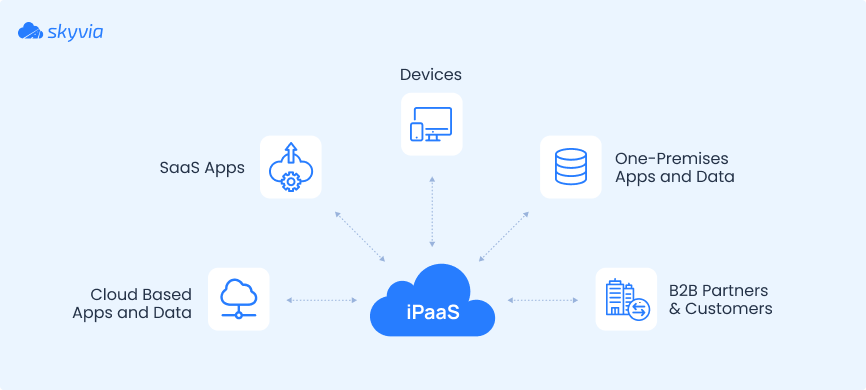
Message-Oriented Middleware (MOM)
Distributed computing became a technological boom several decades ago. It enabled companies to use resources more efficiently and augment the computational capabilities of the entire system.
To make communication between the nodes of the distributed system, the message-oriented middleware, or simply message brokers, was used. They act as intermediaries between the components by transmitting messages from one node to another.
Message brokers are crucial for real-time data streaming, IoT systems, and microservices architecture.
API Gateways
An API Gateway is a secure mechanism that provides access to the backend part of your digital system through REST API or another architectural model. It accepts API requests from the client and sends them to the appropriate points for execution. Afterwards, it sends the response to the Client about the status and outcome of the operation.
API Gateways are popular in microservices-based architectures. Those are the only ways enabling microservices to communicate, interact, and exchange information with each other.
Top Middleware Integration Tools for 2025: A Comprehensive Comparison
MuleSoft Anypoint Platform
MuleSoft Anypoint Platform is a dedicated solution for API management designed by Salesforce. It comprises a set of essential instruments for building, deploying, and coordinating APIs. This platform facilitates integration of applications in the cloud, on-premises, and in hybrid environments.
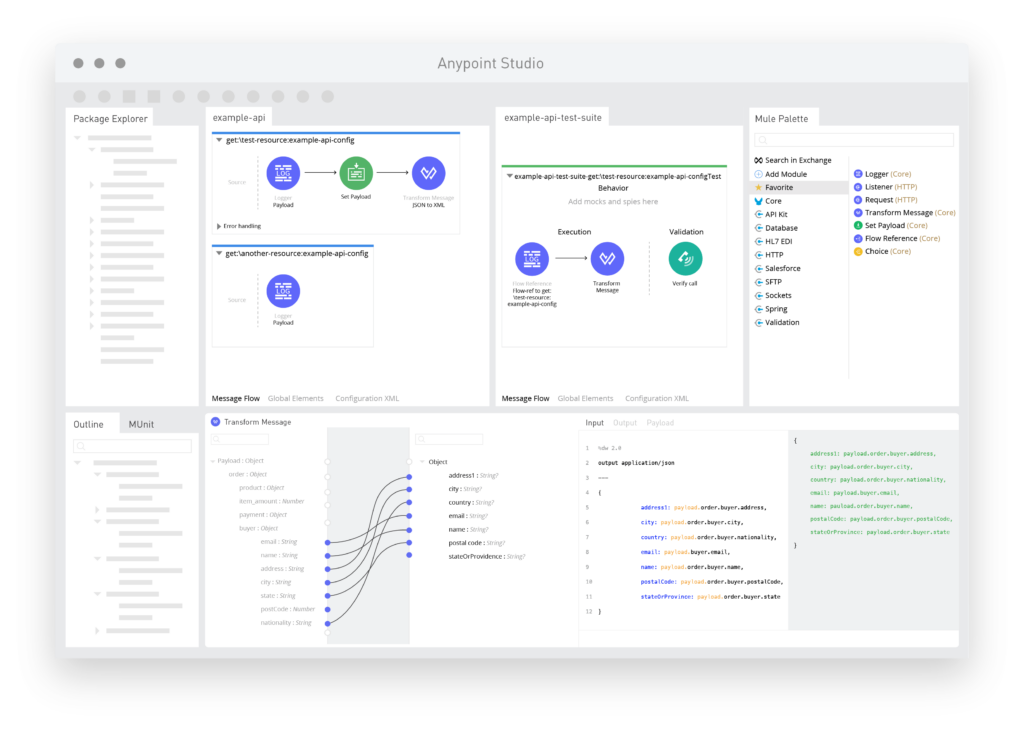
Key Features
- API Lifecycle Management. Anypoint ensures a comprehensive workflow for APIs, from creation to elimination or modification.
- Application Network. Mulesoft tool allows users to design an application network, meaning that the APIs and integrations can be shared and reused across the organizational IT infrastructure.
- Robust security. The platform implements security mechanisms, such as data tokenization, API protection, policies, and many more.
- API monitoring. It provides the instruments for real-time tracking of the APIs and integrations, allowing you to spot any discrepancies or errors efficiently.
Pros
- A unified access via a web-based interface to all functions needed for API management.
- Ability to handle both simple point-to-point connections and advanced enterprise-level integrations.
- Assistance in speeding up the development process.
- Promotion of the efficient collaboration of teams within an organization.
Cons
- Mulesoft Anypoint is associated with high pricing.
- There are limitations on the maximum possible number of APIs.
- Validation rules can’t be applied to standard objects that are created during the Salesforce linking process.
Ideal Use Case
Mulesoft Anypoint would be particularly suitable for enterprise-level organizations that need to build complex integrations and have a considerable budget for software.
Dell Boomi
Boomi is an iPaaS platform, a middleware that simplifies integration between various services, devices, and applications. Even though this tool is cloud-based, it can bring together not only SaaS solutions but also on-premises instances. As a result, it enables the creation of the organization-level digital system with all necessary data in one place.
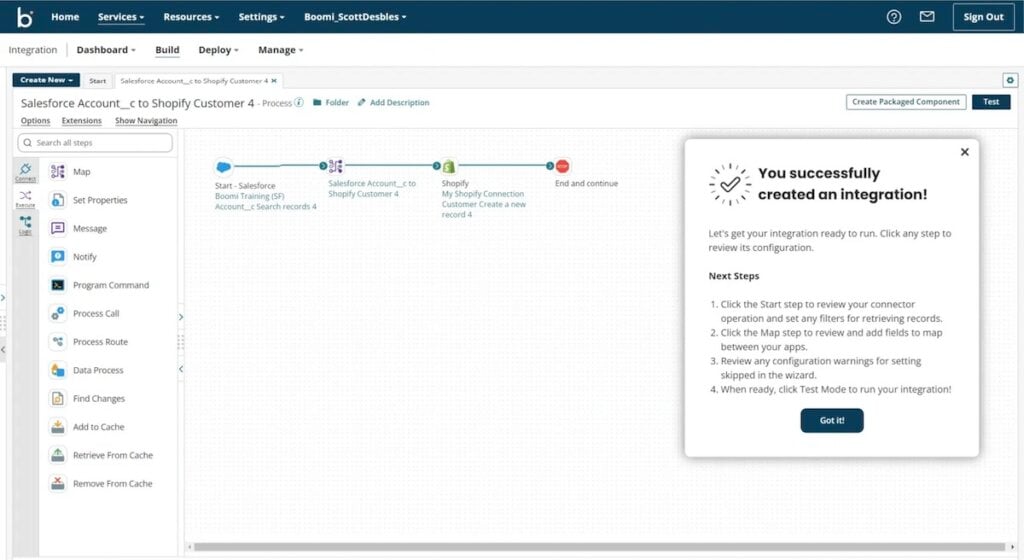
Key Features
- Data management. Boomi comprises tools for effective data management, including those for its discovery and quality assessment.
- Enterprise-grade governance. This platform includes governance mechanisms for ensuring data security and compliance.
- API management. Boomi has all the essential features for building, deploying, and managing APIs.
- Drag-and-drop interface. This iPaaS utilizes a no-code/low-code approach, allowing both tech and non-tech users to create integration workflows using visual building blocks.
Pros
- Enhanced data accuracy and consistency owing to the centralized Master Data Hub.
- Improved data quality due to validation, deduplication, and cleansing approaches.
- Automated workflows and reduced probability of human errors.
- Support of real-time integration scenarios.
Cons
- Possible performance issues when operating large data volumes.
- The cost of this platform may be high for small businesses.
- Unique integration scenarios might require custom scripting.
Ideal Use Case
This tool may be suitable for medium and large companies that need a flexible and scalable integration platform.
Jitterbit
Jitterbit is another iPaaS that serves as a unified system for integration management. It allows you to connect dispersed applications and systems. Thanks to its no-code approach, users without programming knowledge can build and manage integration scenarios.
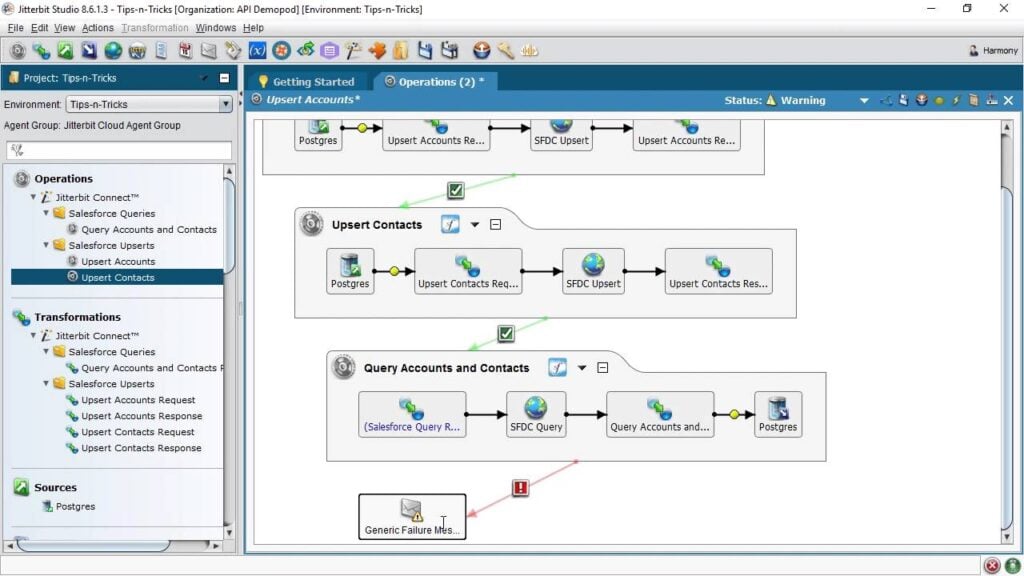
Key Features
- Data management capabilities. Jitterbit provides a wide range of functions for data transformation, cleansing, and quality checks.
- API management. This platform enables users to build and expose APIs.
- AI assistants. Jitterbit embeds AI-powered bots that generate tips on how to build integrations.
- Monitoring board. The system implements robust surveillance, allowing users to detect any errors in the integration functioning.
Pros
- Convenience in use even for non-tech professionals.
- Increased agility, which is favorable for changing needs towards integrations.
- Elevated security guaranteed by the obtained certificates ISO 27017 and ISO 27018.
- Affordability for small and medium-sized businesses.
Cons
- Outdated documentation doesn’t correspond to the actual platform appearance, causing difficulties in using it.
- Maintenance issues related to logging problems and limitations.
- Restricted customization capabilities for highly complex integrations.
Ideal Use Case
Jitterbit is a suitable middleware for small and medium-sized businesses that require a fast and efficient integration solution without a dedicated IT team.
Workato
Workato is a workflow automation platform that helps businesses to streamline their operations. It allows for quick and easy building of automated workflows between cloud and on-premises digital systems. Both business users and IT teams will find it easy to operate this tool.
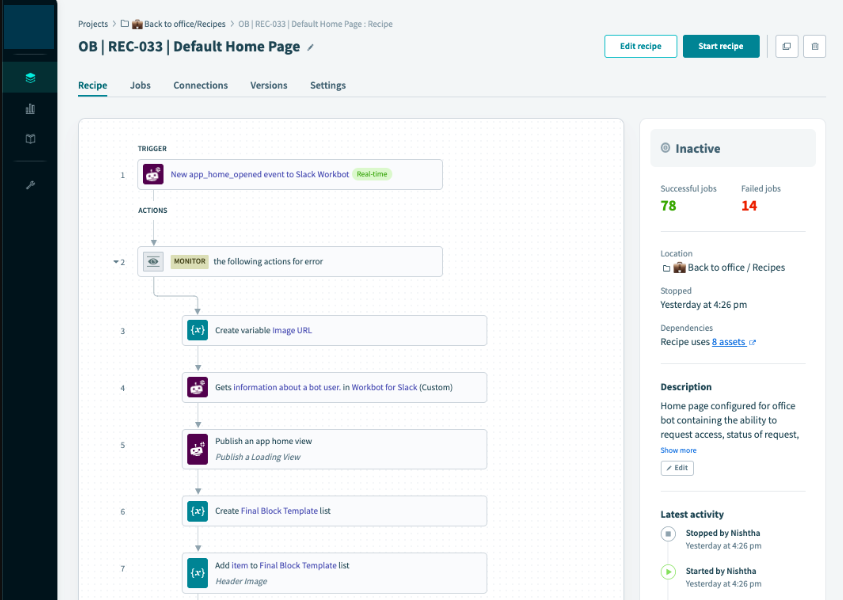
Key Features
- Data integration. Workato connects to various on-premises and cloud-based applications and elaborates on their data by applying mapping, transformation, and aggregation.
- API management. The platform lets you build, run, and publish APIs to create the connection network.
- IT governance. Workato Aegis offers mechanisms for assigning different roles to business and IT users. It also implements policies to enhance enterprise-grade security levels when working with this platform.
- Conversational bots. This tool embeds bots on Slack, Microsoft Teams, and IBM Workspace for building integration and automation workflows.
Pros
- Scalability that adapts to your actual business workflows.
- Increased efficiency thanks to the conversational bots and other useful features.
- Efficient collaboration between all enterprise employees involved in the data automation and integration processes.
Cons
- Data limitations impact flexibility in some integration scenarios.
- This tool can be expensive if advanced features are needed, which might be a burden for startups.
- Point-to-point integrations require robust security measures to properly protect sensitive data.
Ideal Use Case
Workato would be a good option for companies that need to automate their business processes with AI-based features to enhance the overall organizational productivity.
IBM App Connect
IBM App Connect is a middleware integration solution that allows you to connect various applications across your IT ecosystem. This tool can be used with either on-premises or cloud infrastructures.
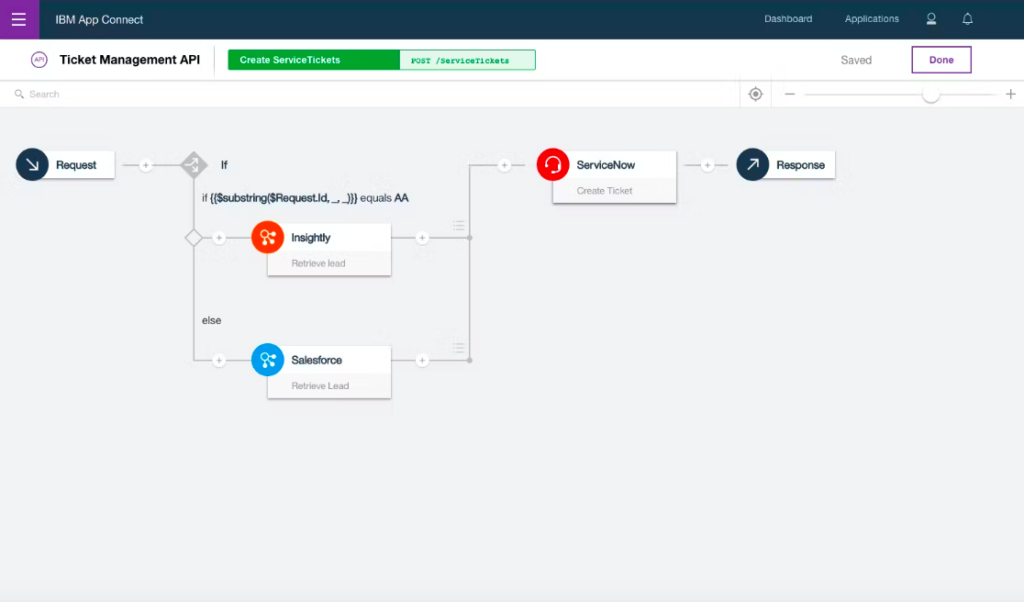
Key Features
- Pre-configured connectors. IBM App Connect implements pre-made connectors to popular applications for e-commerce, customer management, sales, accounting, and so on.
- Support for different integration scenarios. This tool can work with API integration, microservices, and SOA.
- AI assistant. It simplifies the process of connecting services by suggesting optimal field mapping.
- Developer tools. IBM App Connect offers mechanisms for building advanced integrations in your preferred programming languages.
Pros
- Flexibility to businesses since it can be deployed either in the cloud or on-premises.
- Centralized control over all integration scenarios, which enables users to detect and fix any issues promptly.
- Encryption algorithms and security standards ensure data integrity.
- Intuitive interface and simplified management promote better collaboration across teams.
Cons
- Connectivity issues that sometimes might impact the middleware performance.
- Complex integrations and configurations require developer help.
- A steep learning curve may prevent the immediate use of this solution.
Ideal Use Case
IBM App Connect is a popular middleware solution for large enterprises with legacy systems and complex integration requirements.
Why Skyvia is the Smart Choice for Your Business
We have talked about five middleware tools, and now it’s the right time to mention another one.
Skyvia is a universal cloud platform designed for a wide range of data-related tasks, from querying to API endpoint creation. Skyvia is simple to use, but at the same time, it has powerful functionality.
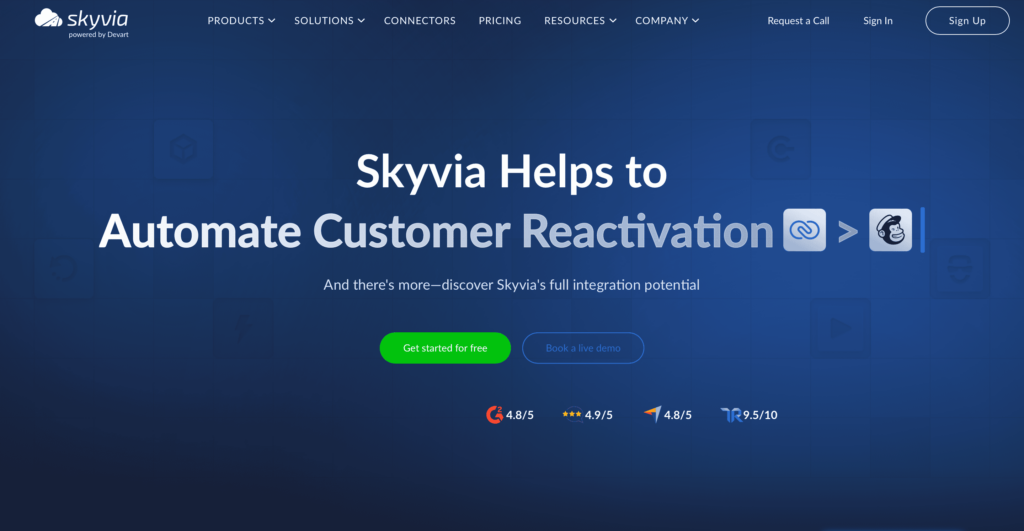
Here are some of Skyvia’s competitive advantages:
- Affordability. This tool offers cost-effective pricing plans suitable for small, medium, and large enterprises.
- Intuitive interface. Skyvia provides a user-friendly GUI with drag-and-drop functionality, making it an ideal choice for business users as well as for tech professionals.
- Pre-built connector library. There are more than 200+ pre-configured connectors to applications, tools, and services for sales, e-commerce, accounting, and other domains.
- All-in-one solution. Apart from the integration capabilities, Skyvia offers a range of other solutions for data backup, querying, workflow automation, and API endpoint creation. All of them are managed within a single admin dashboard.
Now, let’s have a closer look at each of Skyvia’s products:
- Data Integration lets you build ETL, ELT, and Reverse ETL pipelines, both simple and advanced ones.
- Automation allows you to streamline workflows and automate repetitive tasks.
- Query enables you to extract data from any source via SQL queries or a visual SQL builder.
- Backup allows businesses to back up critical cloud app data and restore it when necessary.
- Connect lets you create API endpoints or SQL endpoints for any data source.
How to Choose the Right Middleware Integration Tool: A Step-by-Step Guide
The integration solution market is vast, offering a number of options for consideration. However, it’s necessary to be very attentive when opting for the right middleware option.
Tools with brand names aren’t always suitable for every company. Meanwhile, some lesser-known solutions might be more efficient in certain cases.
When selecting the middleware integration tool, you need to pay attention to the following criteria provided in the table below:
| Compatibility | Make sure that the chosen service will be easily inserted into your existing IT ecosystem. |
| Scalability | Check whether a particular tool supports changing data loads and can easily upscale or downscale as your workloads alter. |
| Integration capabilities | Define which systems you need to connect and estimate the approximate data volume and complexity. Then, juxtapose your integration needs with the middleware capabilities to decide whether it matches your expectations or not. |
| Budget | Inspect the pricing plans of the solutions that interest you and see how they match the sum you are willing to invest. |
| Expertise | Decide who will use the middleware on the team. If those are business users, they will likely need a no-code tool, while developers will be fine with solutions that require programming for integration configuration. |
Conclusion: The Future is Connected
After having read this article, you know what middleware is and which of its types are popular. You have also discovered the top middleware integration tools in the market, along with their features, advantages, and limitations.
To choose the appropriate tool from the list of available options, you need to consider your budget, data volume, current tech stack, integration needs, and technical expertise on the team. Skyvia is a universal solution since it offers a simple and intuitive interface, but powerful functionality at the same time.
Its pricing plans vary from basic to enterprise-level, so any business will benefit from the solution. What’s more, Skyvia is multifaceted, providing various products for different kinds of data-related operations. Feel free to sign up for a free trial to experience the benefits of this middleware.
F.A.Q. for Middleware Integration Tools
Can I use multiple middleware tools?
Sure, you can use many different middleware tools as long as they are compatible with your current infrastructure, satisfy scaling needs, contain the needed integration capabilities, and fit your budget.
How does middleware handle data security?
Inserting middleware in the IT infrastructure tends to enhance the security of the entire tech stack, per se. Each middleware solution embeds a number of encryption algorithms, security protocols, and other mechanisms that ensure data integrity.
How long does it take to implement a middleware solution?
The time to implement middleware depends on the solution itself. If that’s a cloud-based platform like Skyvia, it will take some minutes to create an account. The time to create integration scenarios will depend on their complexity, but pre-built connectors and a visual interface simplify it.


